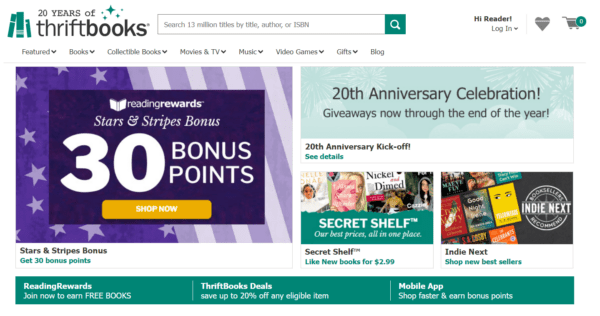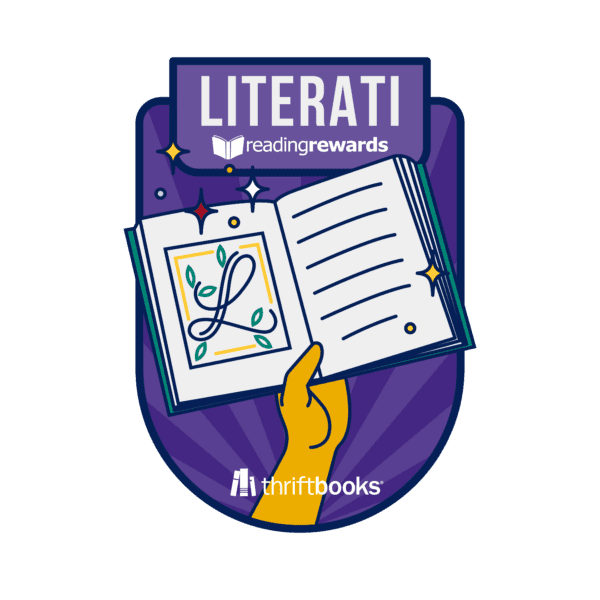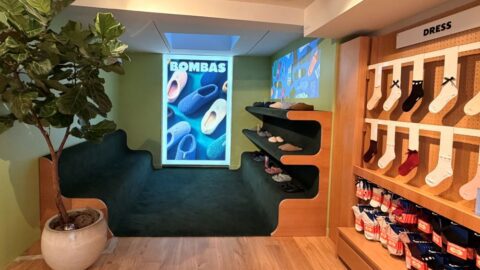Back in the ’90s, when Jeff Bezos was looking for a way into the wide world of the web, he analyzed over 20 different categories to decide which would be the “first best” place to start. He settled on books for the simple reason that “there are more items in the book category than there are items in any other category by far,” as he explained in a 1997 interview (way back when he still had hair).
Bezos was right, and his online bookstore was a success (to put it mildly), but this isn’t a story about Amazon. This is a story about an Amazon seller that has branched out to become one of the ecommerce giant’s biggest competitors in its “first best” category.
Since its launch on Amazon in 2003, ThriftBooks.com has gone on to become one of the world’s largest online independent used booksellers, and has sold more than 250 million books across 160+ countries. ThriftBooks still sells on Amazon today, as well as other marketplaces including Ebay, Walmart and Etsy, but its business is now centered on its own website and the community that has been built around it.
“I want the space that nobody else has,” said Ken Goldstein, Chairman and CEO of ThriftBooks in an interview with Retail TouchPoints. “Everybody wants to go chase the bottom price on Amazon. Let them go do that, we’ve ceded a lot of that space to people. We want people to love ThriftBooks, and we want people to love other people who love ThriftBooks — that was a white space that we could claim, and that’s why we emerged as a brand.”
Anyone who’s ever been, or even knows, an Amazon seller will tell you that’s a lot harder to do than it sounds, in large part because it’s incredibly difficult to build the kind of name recognition that will get consumers to disregard the reach and convenience of Amazon and visit your site instead. ThriftBooks’ ability to do just that has relied on two key pillars:
- Proprietary technology that enables “economies of scale”; and
- A focus on brand and community over price.
“Everyone in the industry thinks that the way you play this game is to have the lowest price,” said Goldstein, who has led the company for the past 10 years. “We don’t always have the lowest price. We have very good pricing, we have everyday low pricing, but we’re not necessarily going to be the cheapest, because you can’t build a company this robust if all you want to do is focus on price. We focus on price, quality, service, selection and loyalty. And by focusing on those five points, we are in fact building a brand and building a branded relationship with our customers, so much so our customers become our advocates.”
Creating Economies of Scale

Leading ThriftBooks is only the fourth job Goldstein has had in his nearly 40-year career, which also included heading Disney’s online business and a stint as Chairman and CEO of Shop.com. In fact, he was semi-retired when he got the call about joining ThriftBooks’ board, and he was initially skeptical: “I went from telling my wife, ‘I don’t know — used books? Why am I going on this meeting?,’ to coming back and telling my then soon-to-be partners, ‘You guys own a gold mine, you’re just not getting enough gold out of the mine. You think you bought a salvage company, but you bought a software company. This is a software platform with infinite potential, and if you want to turn this into the biggest brand in the category, we can do that.’”
That software, which the company calls “Keep Book,” has been central to the business from its founding and remains so today. The company does indeed operate in salvage — in fact it is the biggest buyer of salvage in its category — but it’s what ThriftBooks does with those castoffs from libraries, charities and donation centers that has set it apart.
Behind every truckload of 30,000 books are robust analytics, built up over 20 years, that help the company quickly and efficiently determine whether a book is worth keeping and how to price it. Over the last decade, Goldstein and his team have added onto that with a range of operational automations to make the other pieces of the resale process equally efficient.
“What I fell in love with, as a businessperson, is the uniqueness of this business model — we buy by the pound and sell by the unit,” said Goldstein. “When I joined the company 10 years ago, we were 100% analog, there was no automation at all except our key algorithm. In terms of induction via conveyor, belt, shoots, sorters, splitters, none of that existed, but now all of our processing centers are fully automated.”
The only part of the process that can’t be automated is the quality grading, which is still all done by hand. According to Goldstein that’s essential because “a big piece of the secret sauce of the brand is trust. If we brand it as ‘like new’ or ‘very good’ or ‘acceptable,’ you’ll get what you asked for.”
The Need for Data Obsession
Another ingredient in ThriftBooks’ secret sauce is using that data to “understand how to be profitable at scale,” said Goldstein. “Anybody can be a bookseller. You can go down to Goodwill, buy 100 books, list them on Ebay, no one will stop you,” said Goldstein. “But it is enormously hard to make money at this business. We figured out how to do it very early on, and we’ve never lost money in the history of the company. You can’t understand how to be profitable at this scale if you don’t have the data obsession to understand what every single transaction looks like, to understand what the customer lifecycle is and to understand how much to reinvest,” he added.
And that financial rigor has had other payoffs beyond profitability — it’s allowed the company to invest in its brand and community. “By generating that cash flow month after month after month, we had the ability to plow that cash back into the business and continue to grow. [But with those investments] we focus on what is going to make a better consumer experience. For example, [our VP of Marketing] Barbara is the queen of free books. She loves to give free books to people every day, all day, and the customers love her for it. But every one of those free books is an investment in the customer.”
Building a Community for Book Lovers
ThriftBooks is investing in its customers in many other ways too, and leading the charge is that “Queen of Free Books” Barbara Hagen, who joined four years ago. “We really want to have a place of relevance in customers’ lives,” she said in an interview with Retail TouchPoints.
One of Hagen’s first moves was to switch ThriftBooks’ rewards program from monetary trade-offs to free books (see, her title fits). Now, instead of earning points toward discounts, frequent shoppers earn points toward books. “We translated our rewards into something that customers really value,” she said. “It’s building that community and that relationship with the customer, saying we know what you love and what you value, and it’s books.”

The free ReadingRewards program features different tiers depending on spending level — Reader (free), Bookworm (once shoppers have spent at least $75) and Literati (once shoppers spend $150) — with members earning more points per dollar spent progressively at each tier. These levels have become status symbols of sorts among the ThriftBooks community: “People love to show off when they reach Literati status,” said Hagen. “And they get excited when they’ve earned their next award; they love to share what books they got for free.”
“We operate in a world where our competitors are constantly discounting — sale here, 20% off there — and I think that creates a little bit of buyer’s remorse [where people feel they should have waited for a sale],” said Hagen. “We’ve taken all of that out of our business model. Our approach is around double points and free book credits. That way it’s not about race-to-the-bottom pricing — that becomes a transaction and there’s no relationship being built there.”
Now Hagen is bringing that mentality to a new forum — TikTok’s vibrant #BookTok community. After just a few months on the TikTok scene, ThriftBooks has already gathered close to 160,000 followers, overtaking Barnes & Noble, thanks to that same recipe of authenticity and community spirit.
“When Barbara was trying to get me interested in TikTok, I said, ‘Is this a place that hasn’t been claimed yet?’ And the answer was, yes. Because everybody was out there [with content] that was saying, ‘How do we get customers?,’ but Barbara said, ‘How do I encourage a love of reading?,’ and by doing that we now have this powerful community that’s showing their love of reading,” said Goldstein.

“Part of this community is letting people share their love of reading with other people who love reading, and Barbara brings those people together, whether it’s showing their book hauls or showing the special place at home where they read,” said Goldstein. “This is all about love of a common subject, and it absolutely translates into loyalty and purchase because I don’t have to remind them that we’re here.”
ThriftBooks is doubling down on those community investments to celebrate its 20th anniversary this year with the release of limited edition “Mood Mark” bookmarks and a “Teal Ticket” giveaway that will see six winners get an all-expenses-paid trip to the ThriftBooks processing center in Phoenix, where they can take home as many books as they can carry. Yet another example of knowing what customers will find appealing — and will want to brag about to other members of the community.















